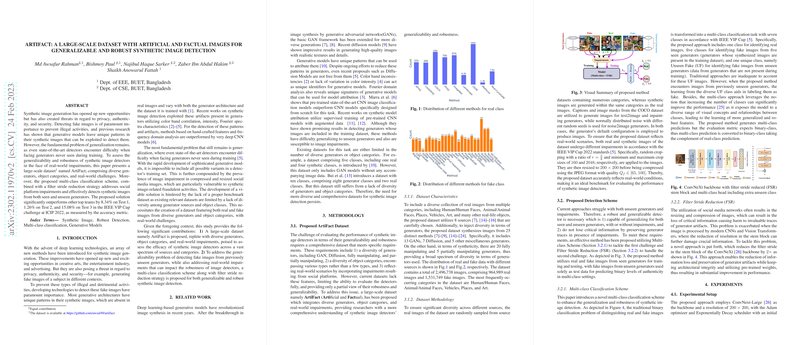Overview of "ArtiFact: A Large-Scale Dataset with Artificial and Factual Images for Generalizable and Robust Synthetic Image Detection"
The paper under review addresses the escalating challenge of detecting synthetic images generated by advanced deep learning frameworks, including GANs and diffusion models. The authors introduce the ArtiFact dataset, a comprehensive compilation designed to improve the evaluation of synthetic image detectors in terms of generalization and robustness.
Key Contributions
- Dataset Development:
- ArtiFact is composed of 2,496,738 images, including 964,989 real and 1,531,749 synthetic images, sourced from 25 diverse synthetic generation methods. The dataset is noteworthy for its inclusion of a variety of object categories and integration of social media impairments, thus imitating real-world conditions effectively.
- The dataset covers an extensive range of generation techniques, encompassing 13 GANs, 7 diffusion models, and 5 other generators, thus offering a broad spectrum of real-to-fake image scenarios.
- Novel Detection Approach:
- The authors propose a multi-class classification scheme enhanced by a filter stride reduction strategy. This approach transforms the binary problem of identifying real versus fake images into a multi-class problem that includes a class for unseen generators.
- A key innovation is the filter stride reduction, which aids in retaining generator-dependent artifacts that might otherwise be diminished by preprocessing operations typical on social media platforms.
- Strong Empirical Performance:
- The proposed methods exhibit superior accuracy over existing techniques, enhancing performance significantly on unseen generators. Notably, it outperformed competitors in the IEEE VIP Cup 2022 by substantial margins in multiple test scenarios.
Methodology and Experiments
The paper's methodology section explores the technical setup of the dataset and detection framework:
- Dataset Characteristics and Construction: The dataset leverages diverse image categories, using sources like COCO for textual and masked data to ensure a wide representation of real-world image contexts.
- Detection Framework: The integration of a multi-class classification approach is particularly noteworthy for its ability to generalize well to images from previously unseen generators.
The authors conducted extensive experiments, including an ablation paper to verify the individual contributions of each component, demonstrating the multi-class scheme's advantage in capturing nuanced distinctions between different types of synthetic imagery.
Implications and Future Directions
The implications of this research extend to various domains where the authenticity of digital images is critical, such as digital forensics, media authenticity verification, and social media platform integrity. The dataset and methodology proposed here set a new standard for evaluating synthetic image detectors under challenging conditions reflective of practical, real-world applications.
Future work could explore:
- Expanding the dataset with additional object categories and new generation methods as they emerge.
- Enhancing detection techniques to not only identify, but also attribute synthetic images to specific generation methods, which could be paramount in forensic analysis.
- Investigating the applicability of these methods to other types of synthetic media beyond still images, such as video or audio, which are increasingly subjected to sophisticated generative techniques.
In conclusion, the ArtiFact dataset and its accompanying methodology represent a significant stride forward in the domain of synthetic image detection, offering a robust toolset for researchers and practitioners focusing on maintaining digital media authenticity.
